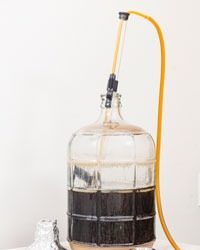Understanding Malt Lingo
There are plenty of technical terms that surround the cereal grains that we brewers use as a source of sugar to make beer. Understanding the brewing jargon used when talking about malt can be very helpful. This column assumes you have a basic understanding of mashing already. If you would like to learn more on the basics of mashing, visit https://byo.com/article/your-first-all-grain-beer/
Malting Talk
Most of the grains that brewers use are of the malted variety. The malting process takes the raw, whole-grain berries, another term for the raw seeds of the grain, and begins the germination process of the berry. Malting is most often done on barley, but wheat, rye, and oats, are a few other popular grains maltsters will utilize. As the grain begins to become metabolically active, it sprouts or chits in malting lingo; some grains that are just barely modified before kilning are called chit malz. The germination process lasts about 3-4 days before it is halted at a certain point when the germination has progressed as far as the maltster requires. At this point the grains are kilned, or dried. Some specialty malts are roasted to varying degrees in a drum roaster, and others are changed by stewing before roasting. Stewing involves taking the newly germinated grains and raising the temperature into the same range that brewers mash their grains. This effectively converts almost all the starch in the grain to sugar prior to the drying/roasting process.
Get A Reaction
There is a class of chemical reactions that occurs in the malting process that every homebrewer should understand, a process known as the Maillard reactions. Maillard reactions create the lion’s share of the characteristic malty flavor and aroma compounds found in beer. Maillard reactions combine a sugar molecule with an amino acid to produce hundreds of flavor-active compounds. The aromas generated from the Maillard reaction intensify as the reaction progresses as temperature and/or roasting time increase. The progression of Maillard reaction products begin with cracker and light toast aromas, then into the caramel, toffee, honey, nutty realm, and finally into roasted aromas like chocolate, coffee, and burnt bread. Maltsters can adjust their process to guide their roast towards different sets of these Maillard reaction products.
Maltsters provide the color contribution of the malt in degrees Standard Reference Method (SRM) (which is based on the Lovibond (°L) scale), or in European Brewery Convention (EBC) units. Utilizing a good calculator, homebrewers can take the color contribution from each malt in the mash and combine them to come up with a general idea of the final beer color via the Morey equation. While this can give brewers a rough idea of the final color of a beer, it has its limitations such as not being able to distinguish brown hues versus red hues.
Feel the Power
One of the most important concepts to understand is diastatic power of a malted grain. So what is diastatic power? It’s basically the grains’ ability to convert the starch into sugar via enzymes, particularly alpha amylase and beta amylase. The more amylase enzymes found in the malt, the more diastatic power. The highest level of diastatic power is found in green malt, in other words malt that has just finished with the germination process. Once the malt enters the kilning process, this level begins to drop as the heat from the kilning process tears apart these enzymes. In general, base malts will have enough diastatic power to convert the starch found in the mash in addition to starch from adjuncts, so long as the brewer does not dilute the base malt enzymes too much. If brewers are using lots of grains with little or no diastatic power, they may want to extend the mash time.
Meet the Families
Steeping grains and mashing grains are two distinct classes of grains that homebrewers should familiarize themselves with. Steeping grains are generally limited to two families of grains, dark roasted grains (such as chocolate malts, black malts, and roasted barleys), and caramel malts (such crystal, cara-types, and Special B/Special W). Basically all other grain families fall into the mashing class, including base malts (such as Pilsen, pale, Vienna, and Munich), roasted malts (such as Biscuit, Victory®, and brown), specialty malts (such as acidulated and rauch), unmalted grains, and miscellaneous malts (like wheat, rye, and oat).
Here’s a truism for you: Mashing grains should be mashed. That’s not to say they have to be. Extract brewers can use them to add some flavor from their Maillard products; just don’t expect much sugar contribution from them if they are simply steeped. Mashing grains contain high levels of starch that brewer’s yeast cannot eat, but other microbes can, which creates an instable beer. Starch can also create a haze in the beer. Partial mashes are a great method for extract brewers who would like to try a mash, without the need for specialized equipment. For more on mashing versus steeping, visit https://byo.com/mr-wizard/101/.



